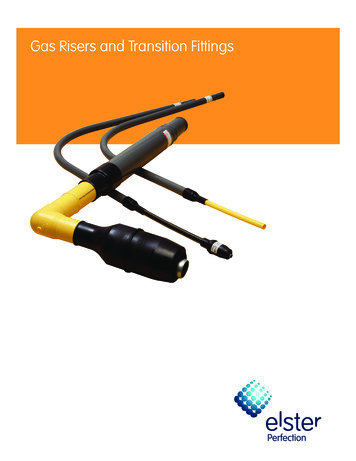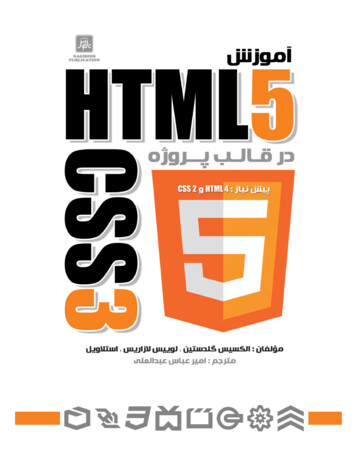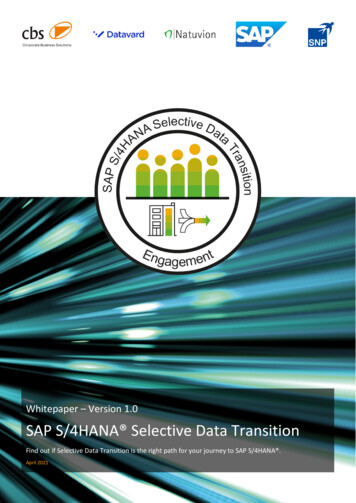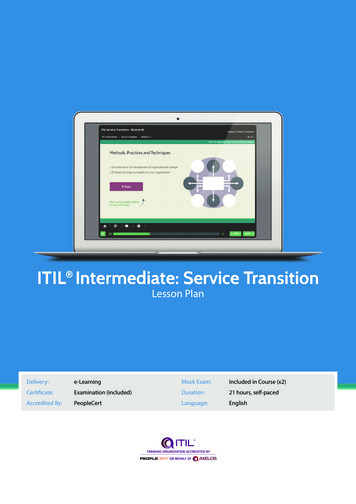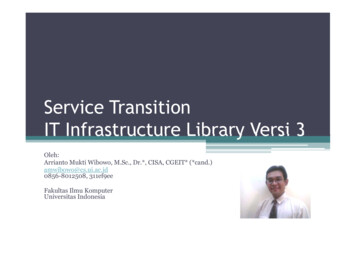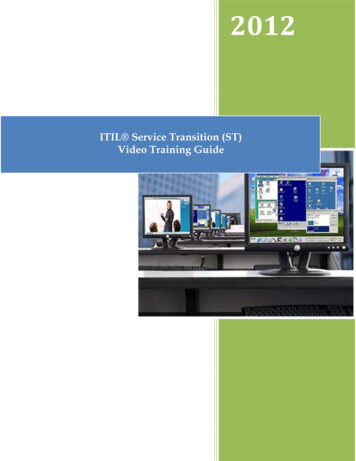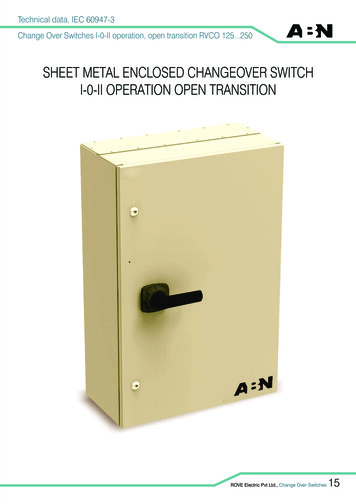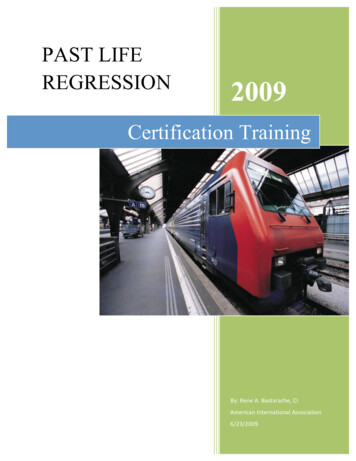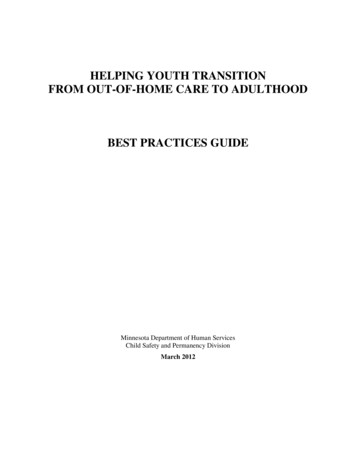
Transcription
HELPING YOUTH TRANSITIONFROM OUT-OF-HOME CARE TO ADULTHOODBEST PRACTICES GUIDEMinnesota Department of Human ServicesChild Safety and Permanency DivisionMarch 2012
ContentsI.INTRODUCTION .1II. ELEMENTS OF TRANSITION PLANNING .2III. LIFE SKILLS ASSESSMENT .2IV. DEVELOPING AN INDEPENDENT LIVING PLAN .3A.EDUCATIONAL, VOCATIONAL, AND EMPLOYMENT PLANNING .5B.TRANSPORTATION .6C.HEALTH CARE – MEDICAL COVERAGE .7D.PLANNING FOR HOUSING .8E.MONEY MANAGEMENT . 10F.SOCIAL AND RECREATIONAL SKILLS . 11G.ESTABLISHING AND MAINTAINING CONNECTIONS . 12H.DISABILITY INCOME ASSISTANCE. 13I.GATHERING VITAL DOCUMENTS . 13V.TEACHING YOUTH INDEPENDENT LIVING SKILLS . 14A.GROUP WORK . 14B.ONE-TO-ONE LIFE SKILLS TRAINING . 15VI. THE SELF PROGRAM – FEDERAL FUNDS TO SUPPORT INDEPENDENT LIVING PLANS . 17A.Eligible Youth . 17B.Use of Funds . 18C.Documentation Required in the Social Services Information System (SSIS) . 19
VII.EDUCATION AND TRAINING VOUCHERS (ETV’S) FOR POST-SECONDARY EDUCATION . 21A.Eligible Youth . 21B.Deadline . 21VIII. HOW CAREGIVERS CAN HELP YOUTH PREPARE FOR INDEPENDENT LIVING . 21IX. FOSTER CARE BENEFITS UP TO AGE 21 . 22A.Case Planning, Reasonable Efforts, and Verification for Youth in Care Up to Age 21. 23B.Legal Responsibility for Continued Placement Up to Age 21 . 24C.Required Judicial Reviews and Determinations . 24D.Youth Under Tribal Jurisdiction . 25E.Foster Care Settings for Youth Up to Age 21 . 26F.Foster Care Maintenance Payment Requirement for All Youth in Care Up to Age 21 . 26G.Eligibility for Health Care Up to Age 21 . 27H.Exit and Re-entry to Care After Age 18 . 27I.90 Day Transition Plan Requirement . 28SELF SUFFICIENCY PREPARATION CHECK LIST . 29HOW CAREGIVERS CAN HELP ADOLESCENTS MEET THEIR NEEDS . 31APPENDIX A. INDEPENDENT LIVING PLAN .APPENDIX B. ONLINE EDUCATION INFORMATION .APPENDIX C. ONLINE EMPLOYMENT INFORMATION .APPENDIX D. ONLINE TRANSPORTATION INFORMATION .APPENDIX E. ONLINE HEALTH INFORMATION .
APPENDIX F. ONLINE HOUSING INFORMATION .APPENDIX G. ONLINE MONEY MANAGEMENT INFORMATION .APPENDIX H. ONLINE SOCIAL AND RECREATIONAL INFORMATION .APPENDIX I. THE FORGOTTEN CHILDREN'S FUND .APPENDIX J. ONLINE INFORMATION ON ESTABLISHING AND MAINTAINING CONNECTIONS .APPENDIX K. IDEAS FOR USE OF SELF FUNDS.APPENDIX L. NOTICE OF FOSTER CARE BENEFITS TO AGE 21 .APPENDIX M. VOLUNTARY FOSTER CARE FOR YOUTH AGES 18-21 .APPENDIX N. 90-DAY TRANSITION PLAN .
I.INTRODUCTIONMinnesota’s county and tribal social workers have a responsibility to assist adolescents in out-ofhome care with preparation for successful adulthood. This work is required by MinnesotaStatutes, section 260C.212 subdivision.1(c)(11). It is also good social work practice andacknowledges a primary adolescent need to discover self and gain autonomy.Minnesota statute requires that youth age 16 and older who are in out-of-home care because of apermanency disposition have an independent living plan. It is important to understand that anindependent living plan does not conflict with, or replace the goal of achieving permanency foradolescents. In fact, youth who are state wards and youth whose permanency disposition is longterm foster care, should be the highest priority for county services that promotes preparation forindependent living and permanency. These youth will leave child welfare system without thesupport of their birth families. It is the counties and tribes responsibility to assure that they leaveout-of-home care with a high school diploma; employment and/or acceptable post-secondaryeducation; health care coverage; a savings account; a safe and affordable place to live; a meansof transportation; knowledge of community resources; and connections to positive adults andfamily members.The purpose of this practice guide is to provide social workers with the information andresources to do this work effectively.The content of this Best Practice Guide includes: Guidance on assessing youth’s independent living skills using an on-line assessmenttool Guidance on developing a complete and meaningful Independent Living Plan Resources for each section of the Independent Living Plan Information on teaching youth life skills and where to find curriculum An explanation of the Support for Emancipation and Living Functionally (SELF)program, which provides counties with funding to help prepare youth for adulthood Information on how caregivers and other significant adults can help prepare youth foradulthood.Why is this work important?Research1 shows that youth transitioning from out-of-home placement: Are more likely to be involved in the criminal justice system Are at higher risk of teen pregnancy and parenting Have lower reading and math skills and high school graduation rates1Courtney, M. E., & Dworsky, A. (2005). Midwest evaluation of the adult functioning of former foster youth: Outcomes atage 19. Chicago, IL: Chapin Hall Center for Children at the University of Chicago1
Have disproportionately high rates of physical, developmental, and mentalhealth problemsAre more likely to experience homelessnessHave higher rates of alcohol and other drug abuseHave higher rates of unemployment and likelihood of dependence onpublic assistanceAre likely to be living with parents or other relatives within one year ofleaving placement.Why does this picture look so bleak? It is partly because of the circumstances under whichchildren enter placement – abuse and/or neglect, which affects their ability to learn and formhealthy relationships. It is also because of what happens to them once they are in the childwelfare system. Youth may experience disrupted placements and frequent moves. There arealso societal barriers, such as poverty, racism, and substance abuse that negatively affectfamilies and youth from achieving successful outcomes. Collectively, families, agencies andcommunities must improve the experience of out-of-home placement to mitigate the negativeoutcomes associated with placement. Although youth transitioning out-of-home placementclearly face many challenges, they have the ability to succeed in life with the support ofcaring adults and communities. It is the county agency’s job to help youth identify theirstrengths and acquire skills so that they can realize a future filled with promise.II.ELEMENTS OF TRANSITION PLANNING Assessment of hard skills: Hard skills are tangible skills that can be taught according to alearning plan. Assessment of soft skills: Soft skills are developed through social experiences. Developing an Independent Living Plan with the youth’s participation. Gathering essential documents: Documents such as a certified copy of their BirthCertificate, a Social Security card, and a state identification card are required for basicadult living. Neither housing nor jobs can be obtained without these documents. Youthneed a safe place to store their documents and also need to know the process for replacingthem if they get lost. Teaching youth life skills. Developing permanent connections with caring adults.Each of these elements is covered in the following pages.III.LIFE SKILLS ASSESSMENTA young person’s plan for independent living should be based on an assessment of their lifeskills. DHS recommends the Ansell-Casey Life Skills Assessment (ACLSA) which isavailable at www.caseylifeskills.org. The ACLSA is an assessment of youth independent livingskills. It consists of statements about life skills that the youth and his/her caretakers complete.The resulting ACLSA Score Report should be used as a starting point for discussion anddevelopment of an independent living plan by the social worker, the youth, the caretakerand other supportive adults in the youth’s life.The ACLSA is appropriate for all youth in placement.2
Additional information on the ACLSA: The ACLSA and the scored report are free. No permission is needed to use the ACLSA or any of the tools at the Ansell-CaseyWebsite. There are versions of the ACLSA for four age groups. The assessment for youth ages16-18 has 118 questions. The ACLSA full-length assessment takes 15-30 minutes to finish. There is a shortassessment, but it is not recommended. Supplements to the ACLSA are available that apply specifically to youth who are NativeAmerican, gay or lesbian, pregnant or parenting, and to assess youth’s values oreducation. Youth can be assessed as often as appropriate for their situation. The ACLSA Score Report contains the assessment score, a brief description of how thescores are calculated and a summary of the responses. The assessment is scoredelectronically and will pop up on the computer screen within one minute of clicking the“I’m Finished” button at the end of the assessment. If the youth or caregiver does not have access to a computer, they can complete a paperversion of the ACLSA. Their paper responses can then be entered into the ACLSAonline and a Score Report will be sent via e-mail to the computer the data wasentered into. A free Life Skills Guidebook is available on the Casey Website and can be used with theScore Report to create a customized life skills teaching plan. It includes activities andexercises that can be used for teaching youth.In addition to the ACLSA, other assessments that youth have completed should be considered.These may include: Psychological test results Vocational interest and aptitude tests (available free at Workforce Centers) Academic assessments.IV.DEVELOPING AN INDEPENDENT LIVING PLANMinnesota Statute Section 260C.212 subdivision 1(c)(11) requires “an independent livingplan for a child age 16 or older who is in placement as a result of a permanency disposition.The plan should include, but not be limited to, the following objectives: Educational, vocational, or employment planning Health care planning and medical coverage Transportation, including, where appropriate, assisting the child in obtaining adriver’s license Money management Planning for housing Social and recreational skills Establishing and maintaining connections3
The Independent Living Plan form that includes these objectives is in the Social ServicesInformation System (SSIS) in the service plans folder. To create a new Independent Living Plan,choose “New Plan” from the action button and search for the Independent Living Plan indocument templates. (See Attachment A for the Independent Living Plan form.)The Independent Living Plan should not necessarily be limited to the objectives listed in thispublication. The plan provides for additional objectives to be added. The Independent LivingPlan should be developed from information gathered from the Ansell-Casey Life SkillsAssessment, and any other psychological, educational, or vocational testing the youth hasundergone.Youth should steer the development of their Independent Living Plan. Schedule a meetingwhich includes the youth and their current caregiver, and have a conversation about the results oftheir completed Ansell Casey Assessments. The youth and his/her caretaker might assess theyouth’s life skills differently, which can lead to a productive discussion. Ask the youth to listadditional supportive people in their life who can help them carry out an independent living plan.This list might include friends, parents, extended family members, teachers, religious leaders, anemployer, a neighbor, etc., and invite them to a meeting to participate in the planning.Focus the initial meeting on the youth’s strengths and start with the skills area they aremost interested in working on. The Independent Living Plan should be based on theyouth’s goals over one, two, or five years, addressing steps needed to accomplish the goals andovercome barriers. Goals and objectives should be specific to the youth’s age, individualinterests, culture, and the region in which they live. Include some long-term goals, as youth maynot see, for example, why they should attend school regularly.The plan should be reviewed and updated every six months. The youth may think of additionalsupportive people in his/her life that should be invited to meetings that update the plan. Newinformation should be added to the plan, and goals and objectives should be written specific tothe changes in assessment data, age, experiences, previously mastered goals, and maturity.Everyone involved in the development of the Independent Living Plan, most notably theyouth, should sign it. A signed copy should be kept in the case file.Family Group Decision Making providers statewide are trained on how to use this process tocreate Transition Plans for youth. Contact a local provider for help with meeting arrangementsand facilitation. Although statewide, availability of this option will vary by county.The following pages offer information and list resources for each of the Independent Living Planobjectives required by Minnesota Statute, as well as samples of goals and objectives that mightbe included in the Independent Living Plan. Each outcome in the Independent Living Planbecomes a goal by including the date by which the youth will master the goal.4
A.EDUCATIONAL, VOCATIONAL, AND EMPLOYMENT PLANNINGPractice Recommendations: Stay in communication with the youth’s school. Stay focused on school stability and continuity – it is critical for educationalsuccess. Monitor the educational progress and planning of each youth – attendIndividualized Education Program (IEP) or 504 accommodation plan meetingsand provide informed input to assure integration with the child welfare drivenIndependent Living Plan. Identify one person in the school to take a special interest in the youth and toact as their advocate. Involve parents and caregivers – encourage them to develop relationships withschool staff, know where to go when there are school problems, and providehomework support. Ensure the collection of all educational records for youth. Help youth attain aptitude and vocational interest assessments. Assure that youth benefit from career development, vocational and jobtraining offered through their high school. Encourage extracurricular activities to help youth develop positive socialskills and self-esteem. Encourage obtaining a high school diploma rather than a GED – youth with aGED tend to have lower post-secondary enrollment and earnings than thosewith a diploma. Arrange for post-secondary education planning and supports. Be aware that youth under state guardianship (i.e. state wards) are eligible fortuition waivers at Minnesota state colleges and universities Become familiar with Education and Training Vouchers that will help formeryouth in care pay for post-secondary education planning services – seepage 20. Information is also available online ce GET DYNAMIC CONVERSION&RevisionSelectionMethod LatestReleased&Redirected true&dDocName id 000553 Familiarize yourself with the Free Application for Federal Student Aid(FAFSA) http://www.fafsa.gov Help youth identify natural skills and abilities Encourage career exploration Support development of job readiness skills and employment skills solutions Work with job placement agencies Develop employment-based collaborations between business, social services,education and employment agencies (i.e. internships, volunteerism and paidemployment). Participate in work competency training and receive a certificate.5
Sample goals and objectives for Independent Living PlanBy June 2016, youth will complete and education plan that will include:Skills/Behaviors: Attend educational program regularly Follow academic and behavioral expectations at school Demonstrate acceptable attendance Master studies by maintaining a 2.0 grade point average each quarter Complete homework and class work on time Ask for help when needed Become involved in an extracurricular activity at school Identify GED testing site Successfully master the GED assessment Use the Minnesota Career Information System to explore careers andpost-secondary education Participate in school conferences Take the ACT Test Identify and apply to three post-secondary institutions Complete financial aid paperwork Establish long and short term employment goals Attend a job or career fair Identify and use many resources to locate employment, including newspapers,local employment agencies, yellow pages, etc. Complete a resume and cover letter Complete and return two job applications Learn about potential job interview questions by participating in a mock jobinterview Go to a job interview with appropriate dress, grooming and materials Spend one or more days job shadowing a person who works in that area orinterest Demonstrate good attendance at work Get to work on time for scheduled shifts Demonstrate self-control, leadership skills, group cooperation, angermanagement, and ethical behavior at work Demonstrate appropriate appearance at work by following dress code andmaintaining clean and professional work clothing.See Appendix B for Educational Information and Resources OnlineSee Appendix C for Employment Information and Resources OnlineB.TRANSPORTATIONPractice Recommendations: Arrange opportunities for youth to learn to use public transportation Provide the youth with bus cards6
Plan with the foster parents the steps necessary to become a licensed driverArrange for youth to take driver’s education and get their driver’s licenseProvide opportunities for youth to practice drivingWhen the youth receives a driver’s license develop a plan with the fosterparents regarding driving privileges and financial responsibilitiesIf foster parents plan to include the youth in their car insurance policy ensurethat the youth is added as a “named insured” or “additional insured.”Help youth learn how to purchase auto insurance and a reliable vehicleHelp youth learn basic car maintenanceProvide youth with a bicycle if they need it for transportation to work.Sample Goal and Objectives for Independent Living PlanBy June 2016, youth will be able to meet his/her transportation needs.Skills Behaviors: Demonstrate ability to read a map and follow directional signs Locate a destination by following both written and verbal directions Identifies and can use public transportation in his/her region of the state Demonstrates ability to read public transportation schedules and maps Knows the privilege and responsibility associated with having their driver’slicense Obtains and studies Minnesota’s driver’s manual Participates in classroom driver’s education classes Obtains a learner’s permit and practices driving the foster parents’ car twice aweek Participates in behind-the-wheel driver’s training Tests for and obtains driver’s license Visits an auto insurance agent to discuss coverage Visits a used car lot with foster parent(s) to learn wise consumer skills Can estimate the cost of owning and operating a car for a month/year Demonstrates knowledge of auto loans and car payments Understands safety guidelines for auto drivers and passengers.See Appendix D for Transportation Information and Resources OnlineC.HEALTH CARE – MEDICAL COVERAGEPractice Recommendations: Arrange comprehensive physical, dental, vision, hearing, mental health andsubstance abuse screenings before youth leaves care. Integrate this informationinto the Independent Living Plan. Arrange home and relationship safety education for youth. Educate youth about their mental health issues, sexual decision-making, andconstructive ways of dealing with stress. Help youth learn to understand how to apply for insurance, access health care, andkeep appointments with health care providers.7
Identify individuals who can help youth maintain safety and wellness.Assist youth in consolidating and updating health records.Sample Goals and Objectives for Independent Living PlansBy June 2016, youth will live a healthy lifestyleSkills/Behaviors: Demonstrate knowledge of health care insurance coverage options Identify name, telephone number and address of dentist, medical doctor andtherapist, and demonstrate how to make an appointment Complete applications for Medical Assistance or MinnesotaCare Demonstrate knowledge of mental/emotional health needs Identify reasons to seek therapy Participate in counseling with a therapist The youth will articulate their need for prescribed medication and knows theside effects and risks associated with them. Demonstrates knowledge of what to do if a mental health crisis occurs Recognizes and correctly use over the counter drugs for pain, fever, etc. Demonstrate use of oral thermometer and how to deal with a cold or the flu Identify food groups that promote a healthy, balanced diet Maintain appropriate weight Demonstrate regular medical and dental care Identify negative effects of cigarette, alcohol and drug use Make healthy choices about cigarette, alcohol and drug use Knows how to prevent pregnancy and the spread of sexually transmitteddiseasesSample Goals and Objectives for Independent Living PlansBy June 2016, youth will practice good emergency and safety skillsSkills/Behaviors: Demonstrate knowledge of smoke detectors and how to change the batteries Demonstrate ability to access emergency telephone numbers and complete firstaid training Complete CPR training Identify common fire hazards Identify household hazards that may cause injury Can determine when to go to the emergency room rather than the family doctoror clinic Demonstrate an understanding of domestic violence and how to seek help.See Appendix E for Health/Medical Insurance Information and ResourcesOnlineD.PLANNING FOR HOUSINGPractice Recommendations:8
Provide life skills trainings that teach you how to live independentlyProvide opportunities for youth to practice living on their own – housekeeping,grocery shopping, cooking meals, working out disputes with roommatesDevelop knowledge of housing issues and housing resources for youth aging outof careCreate alliances with local housing providersEnsure that youth have a safe, affordable place to live when they leave care –discharge to shelter care is not an acceptable planEnsure that youth have received the Notice of Foster Care Benefits to Age 21, andif desires it and meets eligibility criteria, maintain the youth in care in anappropriate placement settingSample Goals and Objectives for Independent Living PlansBy June 2016, youth will locate and plan for appropriate housingSkills/Behaviors: Is knowledgeable about their rights to remain in foster care up to age 21. Demonstrates knowledge of different types if housing available, and is able tocalculate costs related to each option Identifies community resources that assist in locating housing Demonstrates knowledge of a lease’s vocabulary, rights, and responsibilities Demonstrates knowledge of tenant’s rights and responsibilities Identifies supplies and furnishings needed for housing Develops a housing plan that includes a budget, furnishings needed, communitysupports, transportation and employment Develops a safety plan in the event of fire or gas leakSample Goals and Objectives for Independent Living PlansBy June 2016, youth will demonstrate housekeeping skillsSkills/Behaviors: Demonstrates knowledge of cleaning products and their uses Demonstrates use of washing machine and dryer Can sew on buttons and make minor clothing repairs Maintains a clean living space Knows how to use a plunger and prevent sinks and toilets from clogging Knows how to dispose of garbage Can change a fuse or reset a circuit breaker Can do minor household repairsSample Goals and Objectives for Independent Living PlansBy June 2016, youth will demonstrate food management skillsSkills/Behaviors: Disposes of food that has passed the expiration date Stores food appropriately Demonstrates ability to follow recipes and cook meals for one9
Demonstrates ability to plan a menu for a week, develop a grocery list, and carryout the grocery shopping on a limited budget.See Appendix F for Housing Information and Resources OnlineE.MONEY MANAGEMENTPractice Recommendations:Survey of youth who have completed life skills training reveals that money managementwas the most helpful thing they learned. Federal law requires that each child age 16 and older in foster care receive a copy,without cost, of all consumer credit reports each year until discharged from fostercare and that youth are assisted in interpreting the credit report and resolvingany inaccuracies. Engage foster parents or other caretakers in teaching money management skills Help the youth create a monthly budget and open a savings account Involve youth in a life skills training group which includes money management inthe curriculum Involve youth in learning money management skills on-line.Sample Goals and Objectives for Independent Living PlansBy June 2016, youth will demonstrate money management skillsSkills/Behaviors: Has obtained a copy of all consumer credit reports and understands their contents Has resolved any inaccuracies or issues contained in credit reports Develops realistic short and long-term budgets Obtains information about opening a checking and savings account Demonstrates understanding of the procedures for writing and cashing checks Reconciles and balances a mock checking account with sample bank statement Maintains positives balance in a savings account Demonstrates understanding of debit cards and can record debit card transactions. D
skills. DHS recommends the Ansell-Casey Life Skills Assessment (ACLSA) which is available at www.caseylifeskills.org. The ACLSA is an assessment of youth independent living skills. It consists of statements about life skills

